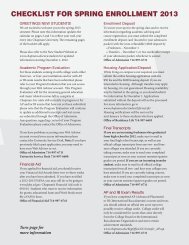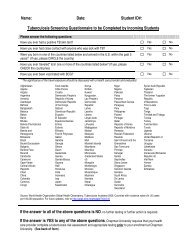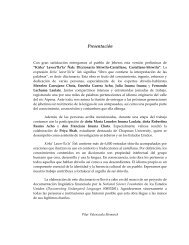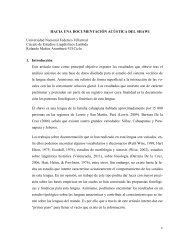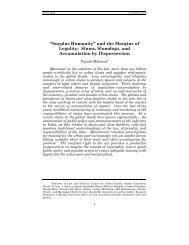The Thirteenth Daimon: Judas and Sophia in the Gospel of Judas
The Thirteenth Daimon: Judas and Sophia in the Gospel of Judas
The Thirteenth Daimon: Judas and Sophia in the Gospel of Judas
Create successful ePaper yourself
Turn your PDF publications into a flip-book with our unique Google optimized e-Paper software.
<strong>The</strong> <strong>Thirteenth</strong> <strong>Daimon</strong>: <strong>Judas</strong> <strong>and</strong> <strong>Sophia</strong> <strong>in</strong> <strong>the</strong> <strong>Gospel</strong> <strong>of</strong> <strong>Judas</strong>Marv<strong>in</strong> MeyerLike my colleague <strong>and</strong> friend Pr<strong>of</strong>essor April DeConick, author <strong>of</strong> <strong>The</strong> <strong>Thirteenth</strong>Apostle: What <strong>the</strong> <strong>Gospel</strong> <strong>of</strong> <strong>Judas</strong> Really Says, I too recently read a text that <strong>in</strong>terestedme greatly but caused me to believe someth<strong>in</strong>g went terribly wrong. 1 <strong>The</strong> text DeConickread was <strong>the</strong> translation <strong>of</strong> <strong>the</strong> <strong>Gospel</strong> <strong>of</strong> <strong>Judas</strong> prepared by <strong>the</strong> National Geographic team<strong>of</strong> translators, which <strong>in</strong>cluded Rodolphe Kasser, Gregor Wurst, François Gaudard, <strong>and</strong>myself. <strong>The</strong> text I read was DeConick’s own book, which puts forward a revisionist<strong>in</strong>terpretation <strong>of</strong> <strong>the</strong> <strong>Gospel</strong> <strong>of</strong> <strong>Judas</strong>.In her book, Pr<strong>of</strong>essor DeConick attempts to correct what she regards as ouroversights <strong>and</strong> to put forward <strong>the</strong> real mean<strong>in</strong>g <strong>of</strong> <strong>the</strong> <strong>Gospel</strong> <strong>of</strong> <strong>Judas</strong>. What sheproduces, she is conv<strong>in</strong>ced, po<strong>in</strong>ts to a totally different gospel than anyth<strong>in</strong>g we mighthave imag<strong>in</strong>ed—a gospel <strong>of</strong> tragedy that is more dysangelium than evangelium. Ipersonally f<strong>in</strong>d <strong>the</strong> <strong>the</strong>sis <strong>of</strong> Pr<strong>of</strong>essor DeConick’s book, that <strong>the</strong> <strong>Gospel</strong> <strong>of</strong> <strong>Judas</strong> is agospel parody, to be <strong>in</strong>terest<strong>in</strong>g <strong>and</strong> provocative, <strong>and</strong> <strong>in</strong> pr<strong>in</strong>ciple I rema<strong>in</strong> open to adocument, ancient or modern, that functions as a tragic or even nihilistic text. In her book<strong>the</strong>re are a number <strong>of</strong> po<strong>in</strong>ts about <strong>the</strong> <strong>in</strong>terpretation <strong>of</strong> <strong>the</strong> <strong>Gospel</strong> <strong>of</strong> <strong>Judas</strong>, <strong>in</strong>clud<strong>in</strong>g hercomments on <strong>the</strong> critique <strong>of</strong> apostolic succession <strong>in</strong> <strong>the</strong> text, that merit seriousconsideration. But what <strong>in</strong>itially bo<strong>the</strong>red me—<strong>and</strong> cont<strong>in</strong>ues to bo<strong>the</strong>r me—aboutDeConick’s book is that everyth<strong>in</strong>g we know about ancient gospels flies <strong>in</strong> <strong>the</strong> face <strong>of</strong> herbasic <strong>the</strong>sis. In genre <strong>the</strong> <strong>Gospel</strong> <strong>of</strong> <strong>Judas</strong> closely resembles o<strong>the</strong>r so-called Gnostic1
gospels, <strong>and</strong> all <strong>of</strong> <strong>the</strong>m proclaim <strong>the</strong> good news <strong>of</strong> salvation through gnosis. I know <strong>of</strong>noth<strong>in</strong>g quite like a gospel parody <strong>in</strong> all <strong>the</strong> literature <strong>of</strong> antiquity <strong>and</strong> late antiquity.Ra<strong>the</strong>r, this idea <strong>of</strong> a gospel parody seems to impose modern, Kafkaesque categories <strong>of</strong>genre onto an ancient text—<strong>and</strong> one that is perfectly comprehensible <strong>in</strong> light <strong>of</strong> ancientgeneric conventions.Accord<strong>in</strong>g to Pr<strong>of</strong>essor DeConick, all <strong>the</strong> apparently positive features <strong>of</strong> <strong>the</strong><strong>Gospel</strong> <strong>of</strong> <strong>Judas</strong> should be treated with a w<strong>in</strong>k <strong>and</strong> an elbow to <strong>the</strong> ribs. Isn’t <strong>the</strong> title <strong>the</strong>“good news” <strong>of</strong> <strong>Judas</strong>? Sure, says DeConick—but it’s really bad news for <strong>Judas</strong>. Whatabout <strong>the</strong> Sethian confession <strong>of</strong> Jesus’ identity uttered by <strong>Judas</strong> <strong>and</strong> <strong>Judas</strong> alone? ForDeConick, this merely provides a hilarious juxtaposition between <strong>the</strong> <strong>in</strong>telligent “baddie<strong>of</strong> <strong>the</strong> baddies” <strong>and</strong> <strong>the</strong> dimwitted twelve. And how to expla<strong>in</strong> <strong>the</strong> textual open<strong>in</strong>g or<strong>in</strong>cipit, promis<strong>in</strong>g revelatory conversations between Jesus <strong>and</strong> <strong>Judas</strong> Iscariot? And Jesus’private revelations to <strong>Judas</strong>, <strong>in</strong>clud<strong>in</strong>g <strong>the</strong> sprawl<strong>in</strong>g cosmogonic revelation thatdom<strong>in</strong>ates <strong>the</strong> central portion <strong>of</strong> <strong>the</strong> text? And Jesus’ repeated statements that he hasrevealed <strong>the</strong> mystery <strong>of</strong> <strong>the</strong> k<strong>in</strong>gdom <strong>of</strong> God to <strong>Judas</strong> <strong>and</strong> told him everyth<strong>in</strong>g? Actually,claims DeConick, this is all part <strong>of</strong> Jesus’ mischievous ploy to let <strong>Judas</strong> know just howevil he is. All <strong>of</strong> this is a cruel joke, even though o<strong>the</strong>r Gnostic gospels present <strong>the</strong>sesame elements as <strong>the</strong> proclamation <strong>of</strong> Gnostic good news. Yes, Jesus laughs a great deal<strong>in</strong> <strong>the</strong> <strong>Gospel</strong> <strong>of</strong> <strong>Judas</strong>, as he laughs <strong>in</strong> o<strong>the</strong>r Gnostic texts, but he says more than once <strong>in</strong><strong>the</strong> gospel that he is not laugh<strong>in</strong>g at <strong>Judas</strong> or <strong>the</strong> o<strong>the</strong>r disciples.So I was <strong>and</strong> still am bo<strong>the</strong>red. I am also disappo<strong>in</strong>ted by <strong>the</strong> accusations, somepr<strong>in</strong>ted <strong>in</strong> Pr<strong>of</strong>essor DeConick’s December 2007 New York Times Op-Ed piece,concern<strong>in</strong>g <strong>the</strong> work <strong>of</strong> <strong>the</strong> translational team that produced <strong>the</strong> <strong>in</strong>itial transcription <strong>and</strong>2
translation <strong>of</strong> <strong>the</strong> <strong>Gospel</strong> <strong>of</strong> <strong>Judas</strong> <strong>and</strong> <strong>the</strong> o<strong>the</strong>r texts <strong>in</strong> Codex Tchacos. DeConick refersto our “mistranslations” <strong>and</strong> <strong>of</strong>fers her own “corrected” versions, when <strong>in</strong> fact bothalternatives are almost always provided <strong>in</strong> <strong>the</strong> popular <strong>Judas</strong> book (<strong>The</strong> <strong>Gospel</strong> <strong>of</strong> <strong>Judas</strong>)<strong>and</strong> <strong>the</strong> critical edition <strong>of</strong> Codex Tchacos (<strong>The</strong> <strong>Gospel</strong> <strong>of</strong> <strong>Judas</strong>, Toge<strong>the</strong>r with <strong>the</strong> Letter<strong>of</strong> Peter to Philip, James, <strong>and</strong> a Book <strong>of</strong> Allogenes, from Codex Tchacos: CriticalEdition). As DeConick must know, <strong>the</strong>se are not “mistranslations” at all, but ra<strong>the</strong>r <strong>the</strong>yrepresent alternative ways <strong>of</strong> underst<strong>and</strong><strong>in</strong>g a difficult text.For example, <strong>the</strong> word daimn (44,21), a term <strong>of</strong> Greek derivation, is used <strong>in</strong> <strong>the</strong><strong>Gospel</strong> <strong>of</strong> <strong>Judas</strong> with<strong>in</strong> a statement <strong>in</strong> which Jesus calls <strong>Judas</strong> <strong>the</strong> “thirteenth daimon,”<strong>and</strong> <strong>the</strong> term may be translated “demon,” understood <strong>in</strong> a negative sense, as DeConicksuggests. But with all <strong>the</strong> references to daimones <strong>in</strong> Platonic, Middle Platonic, Neo-Platonic, Hermetic, <strong>and</strong> magical texts, where <strong>the</strong> term is <strong>of</strong>ten imbued with neutral oreven positive connotations, it may just as easily be translated as “spirit,” as we translatedit, or even “god,” as Pr<strong>of</strong>essors Karen K<strong>in</strong>g <strong>and</strong> Ela<strong>in</strong>e Pagels translate it <strong>in</strong> Read<strong>in</strong>g<strong>Judas</strong>: <strong>The</strong> <strong>Gospel</strong> <strong>of</strong> <strong>Judas</strong> <strong>and</strong> <strong>the</strong> Shap<strong>in</strong>g <strong>of</strong> Christianity. Commonly daimones arethought to be <strong>in</strong>termediary be<strong>in</strong>gs that f<strong>in</strong>d <strong>the</strong>ir place between <strong>the</strong> div<strong>in</strong>e <strong>and</strong> humanrealms.Aga<strong>in</strong>, <strong>the</strong> Coptic verbal form porj= e- (46,17) may be translated as ei<strong>the</strong>r“separate/set apart for” or “separate/set apart from” <strong>in</strong> <strong>the</strong> <strong>Gospel</strong> <strong>of</strong> <strong>Judas</strong>, <strong>in</strong> spite <strong>of</strong>Pr<strong>of</strong>essor DeConick’s suggestions. Accord<strong>in</strong>g to <strong>the</strong> gospel, <strong>Judas</strong> asks Jesus, “What is<strong>the</strong> advantage that I have received? For you have set me apart for—or from—thatgeneration.” Walter E. Crum’s Coptic Dictionary (271b-272a) gives both “be dividedfrom” <strong>and</strong> “be divided <strong>in</strong>to” (reflect<strong>in</strong>g <strong>the</strong> Greek aphorize<strong>in</strong> [etc.] eis) as possible3
mean<strong>in</strong>gs <strong>of</strong> prj e-. So <strong>in</strong>itially we translated <strong>the</strong> phrase at 46,17, which differs from <strong>the</strong>usual construction <strong>in</strong> <strong>the</strong> text <strong>and</strong> codex (prj ebol e-/n- = “separate/set apart from”), with“set apart for,” though a footnote <strong>in</strong> <strong>the</strong> critical edition gives <strong>the</strong> alternate translation “setapart from,” <strong>and</strong> Rodolphe Kasser’s French translation reads “tu m’aies séparé de cette(présente) génération-là.” While I have <strong>in</strong>dicated elsewhere that I also am <strong>in</strong>creas<strong>in</strong>gly<strong>in</strong>cl<strong>in</strong>ed to translate this difficult Coptic phrase as “set apart from,” <strong>the</strong> fact rema<strong>in</strong>s thatei<strong>the</strong>r translation is possible. Karen K<strong>in</strong>g <strong>and</strong> Ela<strong>in</strong>e Pagels are <strong>in</strong> agreement on this po<strong>in</strong>t.Once aga<strong>in</strong>, <strong>the</strong> read<strong>in</strong>g <strong>and</strong> reconstruction <strong>of</strong> <strong>the</strong> Coptic text on <strong>the</strong> bottom <strong>of</strong>page 46 <strong>of</strong> <strong>the</strong> <strong>Gospel</strong> <strong>of</strong> <strong>Judas</strong> have proved to be someth<strong>in</strong>g <strong>of</strong> a nightmare, as Pr<strong>of</strong>essorDeConick is well aware. From <strong>the</strong> beg<strong>in</strong>n<strong>in</strong>g we struggled with <strong>the</strong> obscure <strong>and</strong>fragmentary <strong>in</strong>k traces on <strong>the</strong> papyrus. In <strong>the</strong> spr<strong>in</strong>g <strong>of</strong> 2006 we made our provisionalCoptic transcription <strong>and</strong> English translation available, <strong>and</strong> we kept work<strong>in</strong>g, <strong>in</strong>collaboration with o<strong>the</strong>r scholars, to make sense <strong>of</strong> <strong>the</strong> text. In Paris, at a conference at<strong>the</strong> Sorbonne, where Pr<strong>of</strong>essor DeConick was <strong>in</strong> attendance, <strong>and</strong> <strong>in</strong> Wash<strong>in</strong>gton, D.C., atano<strong>the</strong>r conference she attended, both <strong>in</strong> <strong>the</strong> late autumn <strong>of</strong> 2006, we distributed up-todatetranscriptions to all who wished to see <strong>the</strong> text, <strong>and</strong> <strong>in</strong> 2007 <strong>the</strong> critical edition <strong>of</strong>Codex Tchacos appeared, with <strong>the</strong> follow<strong>in</strong>g translation: “In <strong>the</strong> last days <strong>the</strong>y to you, <strong>and</strong> (that?) you will not ascend on high to <strong>the</strong> holy [generation].” <strong>The</strong> read<strong>in</strong>g at<strong>the</strong> bottom <strong>of</strong> page 46 changed, as might be anticipated, partially on <strong>the</strong> basis <strong>of</strong> <strong>the</strong>additional <strong>in</strong>put <strong>of</strong> Pr<strong>of</strong>essors Wolf-Peter Funk <strong>and</strong> Peter Nagel, as <strong>the</strong> relevant footnote<strong>in</strong> <strong>the</strong> critical edition <strong>in</strong>dicates. But we are still left with a solution <strong>of</strong> desperation: <strong>the</strong>assertion that <strong>the</strong> only way we can make sense <strong>of</strong> <strong>the</strong> text is by assum<strong>in</strong>g a scribal error<strong>in</strong>volv<strong>in</strong>g <strong>the</strong> omission <strong>of</strong> some words <strong>in</strong> <strong>the</strong> Coptic text (<strong>in</strong>dicated by <strong>the</strong> angle brackets).4
What does DeConick assume we sought to do <strong>in</strong> this arduous task <strong>of</strong> read<strong>in</strong>g anexcruciat<strong>in</strong>gly difficult Coptic text? In her Op-Ed piece, she writes, “Perhaps <strong>the</strong> mostegregious mistake I found was a s<strong>in</strong>gle alteration made to <strong>the</strong> orig<strong>in</strong>al Coptic. Accord<strong>in</strong>gto <strong>the</strong> National Geographic translation, <strong>Judas</strong>’s ascent to <strong>the</strong> holy generation would becursed. But it’s clear from <strong>the</strong> transcription that <strong>the</strong> scholars altered <strong>the</strong> Coptic orig<strong>in</strong>al,which elim<strong>in</strong>ated a negative from <strong>the</strong> orig<strong>in</strong>al sentence.” <strong>The</strong>re is hardly a more damn<strong>in</strong>gaccusation that one can make aga<strong>in</strong>st one’s fellow scholars: that we deliberately altered<strong>the</strong> Coptic text for our own purposes, <strong>and</strong> h<strong>in</strong>dered <strong>the</strong> scholarly quest for underst<strong>and</strong><strong>in</strong>g.Noth<strong>in</strong>g could be fur<strong>the</strong>r from <strong>the</strong> truth, as anyone who has observed us <strong>and</strong> our work,<strong>in</strong>clud<strong>in</strong>g Pr<strong>of</strong>essor DeConick, knows. I can only hope that, if given <strong>the</strong> opportunity,Pr<strong>of</strong>essor DeConick would be will<strong>in</strong>g to retract a defamatory charge that somehow cameout wrong. Now <strong>the</strong> same accusation has been picked up by <strong>The</strong> National Review, whichrepeats Pr<strong>of</strong>essor DeConick’s <strong>in</strong>dictment. That is, alas, <strong>the</strong> way sl<strong>and</strong>erous comments getaround. In <strong>The</strong> <strong>Thirteenth</strong> Apostle DeConick goes on to <strong>of</strong>fer a conjecture for how wearrived at <strong>the</strong> earlier read<strong>in</strong>g, guess<strong>in</strong>g that we assumed an o<strong>the</strong>rwise unattestedabbreviation <strong>of</strong> a Greek verb. I recalled noth<strong>in</strong>g <strong>of</strong> <strong>the</strong> sort. Hence, I called Gregor Wurst<strong>in</strong> Augsburg, <strong>and</strong> he assured me that he had recently contacted DeConick to tell her thatshe had misunderstood our translational decision, which was based on a normal Copticidiom found <strong>in</strong> Crum’s dictionary. But now that too is <strong>in</strong> pr<strong>in</strong>t.Pr<strong>of</strong>essor DeConick admits that her <strong>the</strong>sis about <strong>Judas</strong> Iscariot <strong>in</strong> <strong>the</strong> <strong>Gospel</strong> <strong>of</strong><strong>Judas</strong> h<strong>in</strong>ges <strong>in</strong> large part on <strong>the</strong> statement <strong>of</strong> Jesus that <strong>Judas</strong> is <strong>the</strong> “thirteenth daimon,”dest<strong>in</strong>ed to rule over <strong>the</strong> thirteenth aeon or realm. <strong>The</strong> word daimn occurs only once <strong>in</strong><strong>the</strong> extant pages <strong>of</strong> <strong>the</strong> <strong>Gospel</strong> <strong>of</strong> <strong>Judas</strong> <strong>and</strong> Codex Tchacos, <strong>and</strong> Pr<strong>of</strong>essor Antti5
Marjanen notes, <strong>in</strong> a review published on <strong>the</strong> National Geographic website, “S<strong>in</strong>ce <strong>the</strong>word daimn appears only once <strong>in</strong> <strong>the</strong> entire text, some caution should be exercised <strong>in</strong> its<strong>in</strong>terpretation. Even if it is taken as a negative reference, it does not necessarily mean thatit is <strong>the</strong> f<strong>in</strong>al characterization <strong>of</strong> <strong>Judas</strong> <strong>in</strong> <strong>the</strong> text.” <strong>The</strong>re obviously is no developeddemonology <strong>in</strong> <strong>the</strong> <strong>Gospel</strong> <strong>of</strong> <strong>Judas</strong>; <strong>in</strong> fact, even <strong>the</strong> malevolent archons Nebro <strong>and</strong>Saklas are not called demons <strong>in</strong> <strong>the</strong> <strong>Gospel</strong> <strong>of</strong> <strong>Judas</strong>, but angels (angeloi). DeConickexpla<strong>in</strong>s <strong>the</strong> reference to thirteenth, <strong>the</strong> thirteenth daimon, <strong>and</strong> <strong>the</strong> thirteenth aeon bynot<strong>in</strong>g references to <strong>the</strong> thirteen aeons <strong>and</strong> <strong>the</strong> god <strong>of</strong> <strong>the</strong> thirteen aeons—<strong>the</strong> demiurge,<strong>the</strong> creator <strong>of</strong> this mortal world below—<strong>in</strong> <strong>the</strong> Holy Book <strong>of</strong> <strong>the</strong> Great Invisible Spirit <strong>and</strong>Zostrianos from <strong>the</strong> Nag Hammadi library. She also mentions <strong>the</strong> thirteen k<strong>in</strong>gdoms <strong>of</strong><strong>the</strong> Revelation <strong>of</strong> Adam, ano<strong>the</strong>r text from Nag Hammadi, even though <strong>in</strong> this text <strong>the</strong>nature <strong>of</strong> <strong>the</strong> thirteenth k<strong>in</strong>gdom is obscure (see, for <strong>in</strong>stance, Gedaliahu Stroumsa,Ano<strong>the</strong>r Seed: Studies <strong>in</strong> Gnostic Mythology). On <strong>the</strong> basis <strong>of</strong> this limited evidence,DeConick draws far-reach<strong>in</strong>g conclusions—that <strong>in</strong> <strong>the</strong> <strong>Gospel</strong> <strong>of</strong> <strong>Judas</strong> <strong>Judas</strong> Iscariot isan evil demon, a lackey <strong>of</strong> <strong>the</strong> demiurge Yaldabaoth, who is <strong>in</strong> bed with Yaldabaoth <strong>and</strong>is dest<strong>in</strong>ed to hang out <strong>in</strong> <strong>the</strong> thirteenth aeon with Yaldabaoth <strong>the</strong> megalomaniac hereafter.Poor <strong>Judas</strong>! He is told everyth<strong>in</strong>g <strong>in</strong> <strong>the</strong> <strong>Gospel</strong> <strong>of</strong> <strong>Judas</strong>, but <strong>in</strong> <strong>the</strong> end he rema<strong>in</strong>s a poordevil.Pr<strong>of</strong>essor DeConick makes no mention <strong>in</strong> her book <strong>of</strong> an additional referencebrought up by Pr<strong>of</strong>essor Pagels at a meet<strong>in</strong>g <strong>of</strong> <strong>the</strong> Society <strong>of</strong> Biblical Literature <strong>in</strong> SanDiego <strong>in</strong> November 2007. In ano<strong>the</strong>r Nag Hammadi text, entitled Marsanes, a heavenlylocale designated “<strong>the</strong> thirteenth seal” is <strong>the</strong> abode <strong>of</strong> “<strong>the</strong> unknown silent one,” that is,<strong>the</strong> highest God. (Pr<strong>of</strong>essor Birger Pearson has written fairly extensively on <strong>the</strong> thirteenth6
seal <strong>in</strong> Marsanes.) This “thirteenth” realm is a far cry from <strong>the</strong> place envisioned byDeConick, a dreadful doma<strong>in</strong> shared by <strong>the</strong> demiurge <strong>and</strong> his demonic counterpart.Unfortunately, Marsanes didn’t make it <strong>in</strong>to DeConick’s book—so nei<strong>the</strong>r did her“thirteenth apostle” have a chance to make it <strong>in</strong>to Marsanes’ heaven.DeConick also fails to <strong>in</strong>clude <strong>in</strong> <strong>The</strong> <strong>Thirteenth</strong> Apostle a s<strong>in</strong>gle parallelspecifically to <strong>the</strong> phrase “thirteenth aeon,” one <strong>of</strong> <strong>the</strong> key terms <strong>in</strong> <strong>the</strong> <strong>Gospel</strong> <strong>of</strong> <strong>Judas</strong>—<strong>and</strong> a term that occurs prom<strong>in</strong>ently <strong>in</strong> ano<strong>the</strong>r Gnostic text that has been known for a verylong time. In fact, <strong>the</strong> “thirteenth aeon” shows up more than forty times <strong>in</strong> <strong>the</strong> Pistis<strong>Sophia</strong> (<strong>and</strong> it also is to be found <strong>in</strong> <strong>the</strong> Books <strong>of</strong> Jeu), where it is “<strong>the</strong> place <strong>of</strong>righteousness” located above <strong>the</strong> twelve aeons <strong>and</strong> <strong>the</strong> heavenly home <strong>of</strong> <strong>the</strong> twenty-fourlum<strong>in</strong>aries—<strong>in</strong>clud<strong>in</strong>g <strong>Sophia</strong>, who calls <strong>the</strong> thirteenth aeon “my dwell<strong>in</strong>g place.” In <strong>the</strong>literature <strong>of</strong> antiquity <strong>and</strong> late antiquity, <strong>the</strong> thirteenth realm can occupy a place justabove <strong>the</strong> twelve (who are <strong>of</strong>ten considered to be <strong>the</strong> signs <strong>of</strong> <strong>the</strong> zodiac), on <strong>the</strong> border<strong>of</strong> <strong>the</strong> <strong>in</strong>f<strong>in</strong>ite—a place, it may be, between <strong>the</strong> world <strong>of</strong> mortality below <strong>and</strong> <strong>the</strong> world <strong>of</strong><strong>the</strong> div<strong>in</strong>e on high. Sometimes, as <strong>in</strong> Marsanes, <strong>the</strong> thirteenth realm may be taken as <strong>the</strong>locale where <strong>the</strong> transcendent deity dwells. Accord<strong>in</strong>g to <strong>the</strong> Pistis <strong>Sophia</strong>’s version <strong>of</strong><strong>the</strong> myth, <strong>Sophia</strong>, stra<strong>in</strong><strong>in</strong>g to ascend to <strong>the</strong> light above, is deceived <strong>and</strong> comes downfrom <strong>the</strong> thirteenth aeon, descend<strong>in</strong>g through <strong>the</strong> twelve aeons to “chaos” below. Here <strong>in</strong>this world she is oppressed, <strong>and</strong> <strong>the</strong> powers <strong>of</strong> <strong>the</strong> world, <strong>in</strong>clud<strong>in</strong>g lion-faced Yaldabaoth,seek to rob her <strong>of</strong> <strong>the</strong> light with<strong>in</strong> her. For a time, she is prevented from leav<strong>in</strong>g <strong>the</strong> place<strong>of</strong> her oppression. In <strong>the</strong> words <strong>of</strong> Pistis <strong>Sophia</strong>, <strong>the</strong> cohorts <strong>of</strong> Authades, <strong>the</strong> arrogant one,“have surrounded me, <strong>and</strong> have rejoiced over me, <strong>and</strong> <strong>the</strong>y have oppressed me greatly,without my know<strong>in</strong>g; <strong>and</strong> <strong>the</strong>y have run away, <strong>the</strong>y have left me, <strong>and</strong> <strong>the</strong>y have not been7
merciful to me. <strong>The</strong>y turned aga<strong>in</strong> <strong>and</strong> tempted me, <strong>and</strong> <strong>the</strong>y oppressed me with greatoppression; <strong>the</strong>y gnashed <strong>the</strong>ir teeth at me, want<strong>in</strong>g to take away my light from mecompletely.” In <strong>the</strong> midst <strong>of</strong> her suffer<strong>in</strong>g, Pistis <strong>Sophia</strong>—<strong>the</strong> wisdom <strong>of</strong> God weakened<strong>and</strong> languish<strong>in</strong>g <strong>in</strong> this world, reflective <strong>of</strong> <strong>the</strong> soul <strong>of</strong> <strong>the</strong> Gnostic trapped here below—cries for salvation, <strong>and</strong> eventually her cry is heard: “Now at this time, save me, that I mayrejoice, because I want (or, love) <strong>the</strong> thirteenth aeon, <strong>the</strong> place <strong>of</strong> righteousness. And Iwill say at all times, May <strong>the</strong> light <strong>of</strong> Jeu, your angel, give more light. And my tonguewill s<strong>in</strong>g praises to you <strong>in</strong> your knowledge, all my time <strong>in</strong> <strong>the</strong> thirteenth aeon” (1.50,Schmidt-MacDermot).In o<strong>the</strong>r words, <strong>Sophia</strong> comes from <strong>the</strong> thirteenth realm above; she is separatedfrom—<strong>and</strong> separated for—that realm, to use <strong>the</strong> language <strong>of</strong> <strong>the</strong> <strong>Gospel</strong> <strong>of</strong> <strong>Judas</strong>; <strong>and</strong> sheis dest<strong>in</strong>ed to return <strong>the</strong>re aga<strong>in</strong>. While here below, moreover, she refers to herself withano<strong>the</strong>r term that resonates with <strong>Judas</strong>’ portrayal <strong>in</strong> <strong>the</strong> <strong>Gospel</strong> <strong>of</strong> <strong>Judas</strong>: she refers toherself as a daimn. In her fourth repentance, <strong>Sophia</strong> bemoans her fate, say<strong>in</strong>g, “I havebecome like a peculiar demon (daimn), which dwells <strong>in</strong> matter, <strong>in</strong> whom is no light.And I have become like a spirit counterpart (antimimon e mpn(eum)a) which is <strong>in</strong> amaterial body, <strong>in</strong> which <strong>the</strong>re is no light-power” (1.39, Schmidt-MacDermot). Aga<strong>in</strong>, <strong>in</strong>her twelfth repentance, <strong>Sophia</strong> laments that “<strong>the</strong>y have taken away my light <strong>and</strong> mypower, <strong>and</strong> my power is shaken with<strong>in</strong> me, <strong>and</strong> I have not been able to st<strong>and</strong> upright <strong>in</strong><strong>the</strong>ir midst, I have become like matter which has fallen; I have been cast on this side <strong>and</strong>that, like a demon which is <strong>in</strong> <strong>the</strong> air” (1.55, Schmidt-MacDermot). <strong>The</strong> word used for“demon” here is refoor, <strong>the</strong> Coptic equivalent <strong>of</strong> <strong>the</strong> Greek daimonion.8
Hence, <strong>in</strong> a manner that closely parallels <strong>the</strong> portrayal <strong>of</strong> <strong>Judas</strong> Iscariot <strong>in</strong> <strong>the</strong><strong>Gospel</strong> <strong>of</strong> <strong>Judas</strong>, <strong>Sophia</strong> <strong>in</strong> <strong>the</strong> Pistis <strong>Sophia</strong> is likened to a daimon, perhaps as an<strong>in</strong>termediary be<strong>in</strong>g; she is persecuted at <strong>the</strong> h<strong>and</strong>s <strong>of</strong> <strong>the</strong> archons <strong>of</strong> <strong>the</strong> twelve aeons; <strong>and</strong>though long separated from it, she will return to her dwell<strong>in</strong>g place <strong>in</strong> “<strong>the</strong> thirteenth aeon,<strong>the</strong> place <strong>of</strong> righteousness.” That is <strong>the</strong> good news <strong>of</strong> <strong>Sophia</strong> <strong>in</strong> <strong>the</strong> Pistis <strong>Sophia</strong>.<strong>The</strong> Pistis <strong>Sophia</strong> thus raises fundamental questions about DeConick’sunderst<strong>and</strong><strong>in</strong>g <strong>of</strong> <strong>Judas</strong>—<strong>and</strong> any completely negative underst<strong>and</strong><strong>in</strong>g <strong>of</strong> <strong>Judas</strong>—<strong>in</strong> <strong>the</strong><strong>Gospel</strong> <strong>of</strong> <strong>Judas</strong>. Ra<strong>the</strong>r than function<strong>in</strong>g as a boon companion <strong>of</strong> Yaldabaoth, asDeConick proposes, <strong>Judas</strong> may be seen, <strong>in</strong> <strong>the</strong> light <strong>of</strong> <strong>the</strong> Pistis <strong>Sophia</strong>, as <strong>the</strong> spitt<strong>in</strong>gimage <strong>of</strong> <strong>Sophia</strong>. (<strong>Sophia</strong>, or wisdom, is referred to once <strong>in</strong> <strong>the</strong> extant pages <strong>of</strong> <strong>the</strong><strong>Gospel</strong> <strong>of</strong> <strong>Judas</strong>, at 44,4, <strong>in</strong> a fragmentary section, as “corruptible wisdom” or“corruptible <strong>Sophia</strong>.”) It turns out that just this sort <strong>of</strong> l<strong>in</strong>k between <strong>Judas</strong> <strong>and</strong> <strong>Sophia</strong> wasmade by Gnostics already <strong>in</strong> <strong>the</strong> second century, as Irenaeus <strong>of</strong> Lyon <strong>in</strong>forms us—<strong>in</strong> apassage that DeConick mentions <strong>in</strong> her book (but without mak<strong>in</strong>g reference to <strong>the</strong> Pistis<strong>Sophia</strong> <strong>and</strong> without not<strong>in</strong>g <strong>the</strong> implications for <strong>the</strong> <strong>Gospel</strong> <strong>of</strong> <strong>Judas</strong>; I did <strong>the</strong> very sameth<strong>in</strong>g <strong>in</strong> my book <strong>Judas</strong>). Accord<strong>in</strong>g to Irenaeus <strong>in</strong> his Adversus haereses (Aga<strong>in</strong>stHeresies), certa<strong>in</strong> Valent<strong>in</strong>ian Gnostics, who must have been enunciat<strong>in</strong>g <strong>the</strong>ir beliefsaround <strong>the</strong> same time <strong>in</strong> <strong>the</strong> second century when <strong>the</strong> <strong>Gospel</strong> <strong>of</strong> <strong>Judas</strong> was be<strong>in</strong>gcomposed <strong>and</strong> read, established a close connection between <strong>the</strong> suffer<strong>in</strong>g <strong>of</strong> <strong>Sophia</strong> <strong>and</strong><strong>the</strong> passion <strong>of</strong> <strong>Judas</strong>—both be<strong>in</strong>g l<strong>in</strong>ked, says Irenaeus, to <strong>the</strong> number twelve, with <strong>Judas</strong>numbered as <strong>the</strong> twelfth <strong>and</strong> f<strong>in</strong>al disciple <strong>in</strong> <strong>the</strong> circle <strong>of</strong> <strong>the</strong> twelve <strong>and</strong> <strong>Sophia</strong>numbered as <strong>the</strong> twelfth aeon.9
Irenaeus argues aga<strong>in</strong>st <strong>the</strong> Valent<strong>in</strong>ian Gnostics as follows, from his protoorthodoxperspective: “<strong>The</strong>n, aga<strong>in</strong>, as to <strong>the</strong>ir assertion that <strong>the</strong> passion <strong>of</strong> <strong>the</strong> twelfthaeon was proved through <strong>the</strong> conduct <strong>of</strong> <strong>Judas</strong>, how is it possible that <strong>Judas</strong> can becompared with this aeon as be<strong>in</strong>g an emblem <strong>of</strong> her—he who was expelled from <strong>the</strong>number <strong>of</strong> <strong>the</strong> twelve, <strong>and</strong> never restored to his place? For that aeon, whose type <strong>the</strong>ydeclare <strong>Judas</strong> to be, after be<strong>in</strong>g separated from her Enthymesis (thought, reflection), wasrestored or recalled to her former position; but <strong>Judas</strong> was deprived <strong>of</strong> his <strong>of</strong>fice, <strong>and</strong> castout, while Matthias was orda<strong>in</strong>ed <strong>in</strong> his place, accord<strong>in</strong>g to what is written, ‘And hisbishopric let ano<strong>the</strong>r take’ (Acts 1:20). <strong>The</strong>y ought <strong>the</strong>refore to ma<strong>in</strong>ta<strong>in</strong> that <strong>the</strong> twelfthaeon was cast out <strong>of</strong> <strong>the</strong> Pleroma (<strong>the</strong> heavenly fullness <strong>of</strong> <strong>the</strong> div<strong>in</strong>e), <strong>and</strong> that ano<strong>the</strong>rwas produced, or sent forth to fill her place; if, that is to say, she is po<strong>in</strong>ted at <strong>in</strong> <strong>Judas</strong>.Moreover, <strong>the</strong>y tell us that it was <strong>the</strong> aeon herself who suffered, but <strong>Judas</strong> was <strong>the</strong>betrayer, <strong>and</strong> not <strong>the</strong> sufferer. Even <strong>the</strong>y <strong>the</strong>mselves acknowledge that it was <strong>the</strong>suffer<strong>in</strong>g Christ, <strong>and</strong> not <strong>Judas</strong>, who came to <strong>the</strong> endurance <strong>of</strong> passion. How, <strong>the</strong>n, could<strong>Judas</strong>, <strong>the</strong> betrayer <strong>of</strong> him who had to suffer for our salvation, be <strong>the</strong> type <strong>and</strong> image <strong>of</strong>that aeon who suffered?” (2.20, ANF).So Irenaeus—who knew <strong>of</strong> <strong>the</strong> existence <strong>of</strong> a text called <strong>the</strong> <strong>Gospel</strong> <strong>of</strong> <strong>Judas</strong>—admits that <strong>in</strong> <strong>the</strong> second century <strong>the</strong>re were Gnostics who compared <strong>Judas</strong> <strong>and</strong> <strong>Sophia</strong><strong>and</strong> were conv<strong>in</strong>ced that <strong>Judas</strong> was “<strong>the</strong> type <strong>and</strong> image <strong>of</strong> that aeon who suffered.”(Incidentally, he also states, just prior to his reference to <strong>the</strong> <strong>Gospel</strong> <strong>of</strong> <strong>Judas</strong>, that someGnostics declared that after <strong>the</strong> resurrection, Christ, who himself was l<strong>in</strong>ked to <strong>Sophia</strong>,ascended to <strong>the</strong> right h<strong>and</strong> <strong>of</strong> Yaldabaoth for a thoroughly positive purpose—to aid <strong>in</strong> <strong>the</strong>salvation <strong>of</strong> souls.) This admission <strong>of</strong> Irenaeus, comb<strong>in</strong>ed with <strong>the</strong> close similarities <strong>in</strong>10
<strong>the</strong>me <strong>and</strong> term<strong>in</strong>ology <strong>in</strong> <strong>the</strong> presentations <strong>of</strong> <strong>Judas</strong> <strong>and</strong> <strong>Sophia</strong> <strong>in</strong> <strong>the</strong> <strong>Gospel</strong> <strong>of</strong> <strong>Judas</strong><strong>and</strong> <strong>the</strong> Pistis <strong>Sophia</strong> (<strong>and</strong> <strong>the</strong> Books <strong>of</strong> Jeu), allows for a powerful conclusion regard<strong>in</strong>g<strong>the</strong> role <strong>of</strong> <strong>Judas</strong> Iscariot <strong>in</strong> <strong>the</strong> <strong>Gospel</strong> <strong>of</strong> <strong>Judas</strong>. I suggest that among certa<strong>in</strong> Gnostics <strong>of</strong><strong>the</strong> second century, <strong>in</strong>clud<strong>in</strong>g some Valent<strong>in</strong>ians <strong>and</strong> <strong>the</strong> folks who wrote <strong>and</strong> used <strong>the</strong><strong>Gospel</strong> <strong>of</strong> <strong>Judas</strong>, <strong>the</strong> figure <strong>of</strong> <strong>Judas</strong> could be presented <strong>in</strong> terms that are rem<strong>in</strong>iscent <strong>of</strong><strong>the</strong> figure <strong>of</strong> <strong>Sophia</strong>, <strong>and</strong> that <strong>the</strong> account <strong>of</strong> <strong>Judas</strong> <strong>in</strong> <strong>the</strong> <strong>Gospel</strong> <strong>of</strong> <strong>Judas</strong> should be readwith elements <strong>of</strong> <strong>the</strong> fall, passion, grief, <strong>and</strong> redemption <strong>of</strong> <strong>the</strong> wisdom <strong>of</strong> God <strong>in</strong> m<strong>in</strong>d.Like <strong>Sophia</strong> <strong>in</strong> o<strong>the</strong>r texts <strong>and</strong> traditions, <strong>Judas</strong> <strong>in</strong> <strong>the</strong> <strong>Gospel</strong> <strong>of</strong> <strong>Judas</strong> is “separated from”<strong>the</strong> div<strong>in</strong>e realms above, even though he knows <strong>and</strong> pr<strong>of</strong>esses <strong>the</strong> mysteries <strong>of</strong> <strong>the</strong> div<strong>in</strong>e<strong>and</strong> <strong>the</strong> orig<strong>in</strong> <strong>of</strong> <strong>the</strong> savior; he goes through grief <strong>and</strong> persecution as a daimon conf<strong>in</strong>edto this world below; he is enlightened with revelations “that no human will ever see”;<strong>and</strong> at last he is said to be on his way, much like <strong>Sophia</strong>, to <strong>the</strong> thirteenth aeon <strong>of</strong> Gnosticlore.<strong>The</strong> story <strong>of</strong> <strong>Judas</strong>, like <strong>the</strong> story <strong>of</strong> <strong>Sophia</strong>, recalls <strong>the</strong> story <strong>of</strong> <strong>the</strong> soul <strong>of</strong> anyGnostic who is <strong>in</strong> this world <strong>and</strong> longs for transcendence. <strong>The</strong> <strong>Gospel</strong> <strong>of</strong> <strong>Judas</strong> may beunderstood to portray <strong>Judas</strong> as <strong>the</strong> type <strong>and</strong> image <strong>of</strong> <strong>Sophia</strong> <strong>and</strong> <strong>of</strong> <strong>the</strong> Gnostic, <strong>and</strong> <strong>the</strong>text proclaims how salvation may be realized—not, it is emphasized, through a <strong>the</strong>ology<strong>of</strong> <strong>the</strong> cross <strong>and</strong> <strong>the</strong> experience <strong>of</strong> sacrifice (as Karen K<strong>in</strong>g <strong>and</strong> Ela<strong>in</strong>e Pagels show soclearly), but on <strong>the</strong> contrary through gnosis <strong>and</strong> <strong>in</strong>sight <strong>in</strong>to <strong>the</strong> nature <strong>of</strong> <strong>the</strong> div<strong>in</strong>e <strong>and</strong><strong>the</strong> presence <strong>of</strong> <strong>the</strong> div<strong>in</strong>e <strong>in</strong> <strong>the</strong> <strong>in</strong>ner lives <strong>of</strong> people <strong>of</strong> knowledge.Without a doubt this <strong>in</strong>terpretation <strong>of</strong> <strong>the</strong> <strong>Gospel</strong> <strong>of</strong> <strong>Judas</strong> calls <strong>in</strong>to questionmany <strong>of</strong> <strong>the</strong> central tenets <strong>of</strong> an argument for <strong>the</strong> text to be viewed as a gospel parody ora gospel tragedy. Still, a number <strong>of</strong> uncerta<strong>in</strong>ties <strong>of</strong> <strong>in</strong>terpretation will l<strong>in</strong>ger as long as11
<strong>the</strong> lacunae on <strong>the</strong> top portion <strong>of</strong> pages 55-58 <strong>of</strong> <strong>the</strong> <strong>Gospel</strong> <strong>of</strong> <strong>Judas</strong>, with <strong>the</strong> account <strong>of</strong><strong>the</strong> conclusion <strong>of</strong> <strong>the</strong> story <strong>of</strong> Jesus <strong>and</strong> <strong>Judas</strong>, are unresolved. Fur<strong>the</strong>rmore, <strong>the</strong>recerta<strong>in</strong>ly is room for a more nuanced approach <strong>of</strong> <strong>the</strong> text, one which takes seriously <strong>the</strong>diverse features <strong>of</strong> this challeng<strong>in</strong>g document. I suspect that <strong>in</strong> <strong>the</strong> future <strong>the</strong> figure <strong>of</strong><strong>Judas</strong> Iscariot <strong>in</strong> <strong>the</strong> <strong>Gospel</strong> <strong>of</strong> <strong>Judas</strong> may be <strong>in</strong>terpreted, <strong>in</strong> good Hegelian fashion—<strong>and</strong><strong>in</strong> <strong>the</strong> light <strong>of</strong> such parallel texts as those cited here—as nei<strong>the</strong>r a completely positivecharacter nor a totally demonic be<strong>in</strong>g, but ra<strong>the</strong>r a figure, like <strong>Sophia</strong>, <strong>and</strong> like anyGnostic, who is embroiled <strong>in</strong> this world <strong>of</strong> mortality yet is striv<strong>in</strong>g for gnosis <strong>and</strong>enlightenment. To this extent <strong>the</strong>re is room for aspects <strong>of</strong> a revisionist <strong>in</strong>terpretation, likethat <strong>of</strong> DeConick <strong>and</strong> o<strong>the</strong>rs, to be jo<strong>in</strong>ed to <strong>the</strong> positive features <strong>of</strong> <strong>the</strong> <strong>Gospel</strong> <strong>of</strong> <strong>Judas</strong>,to give a balanced approach to <strong>the</strong> text. After all, <strong>Judas</strong>, like <strong>Sophia</strong>, is caught between<strong>the</strong> worlds <strong>of</strong> mortality <strong>and</strong> immortality, look<strong>in</strong>g for liberation, <strong>and</strong> <strong>the</strong> <strong>Gospel</strong> <strong>of</strong> <strong>Judas</strong>shows how liberation may be achieved. Thus, <strong>the</strong> evidence <strong>of</strong> <strong>the</strong> <strong>Gospel</strong> <strong>of</strong> <strong>Judas</strong>,toge<strong>the</strong>r with <strong>in</strong>sights drawn from Marsanes, <strong>the</strong> Pistis <strong>Sophia</strong>, <strong>the</strong> Books <strong>of</strong> Jeu, <strong>and</strong>Irenaeus <strong>of</strong> Lyon, may provide a new set <strong>of</strong> perspectives on <strong>Judas</strong> <strong>and</strong> <strong>Sophia</strong> <strong>in</strong> secondcenturyGnostic literature. What is clear, though, is that <strong>the</strong> mystical message <strong>of</strong> <strong>the</strong><strong>Gospel</strong> <strong>of</strong> <strong>Judas</strong>, however it may be nuanced, rema<strong>in</strong>s supremely good news, from aGnostic po<strong>in</strong>t <strong>of</strong> view, <strong>the</strong> very best news <strong>in</strong> <strong>the</strong> world. In <strong>the</strong> end, gnosis—<strong>and</strong>wisdom—triumph.1 I wish to acknowledge <strong>the</strong> significant contribution <strong>of</strong> Jonathan Meyer to <strong>the</strong> f<strong>in</strong>al formulation <strong>of</strong> <strong>the</strong>argument presented <strong>in</strong> this paper.© 2008 Marv<strong>in</strong> Meyer12




